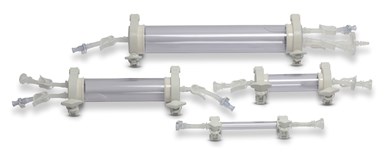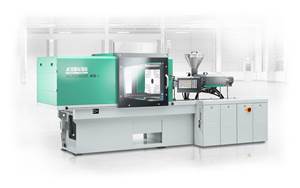PSU Outperforms PC in Sanitary Biotech Sight Gauge
Manufacturer of single-use systems for biotech applications opts for PSU over PC for improved heat and chemical resistance.
Polysulfone (PSU) is being used to manufacture customized tri-clamp sight gauges for bioprocessing applications by SaniSure, Camarillo, Calif., after trials showed it outperformed polycarbonate. A global company that provides novel single-use fluidic systems and components for drug and vaccine manufacturing and other biotech applications, SaniSure opted for transparent Udel P-1700 PSU resin from Solvay Specialty Polymers to achieve superior strength, transparency, heat resistance, hydrolytic stability and retention of mechanical properties under steam sterilization.

High-temperature stability and excellent chemical resistance are claimed for SaniSure’s new tri-clamp sight gauges made from Udel P-1700 PSU.
SaniSure’s capabilities include thermoplastic and thermoset extrusion, molding, assembly and fabrication. Examples of its products include single-use assemblies, bottles, tubing, fittings and fabrications.
In addition to transparent Udel P-1700 PSU, which is extruded into the single-use tubular sight gauges, SaniSure chose an opaque, white grade of Udel PSU for the connection between the sight gauge and the tubing used in various critical bioprocessing applications. This product is injection overmolded onto the sight gauge where a hygienic gasket is affixed with a mechanical clamp. These materials are free of any animal-derived components (ADCF) and meet USP Class VI and ISO 10993 requirements for biocompatibility.
Robert DuPont, SaniSure’s product development manager, considers Udel P-1700 PSU to be a major breakthrough for the pharmaceutical industry. “One key factor in choosing Udel P-1700 PSU resin is the rigorous regulatory testing done by Solvay, particularly for extractables and leachables under the BioPhorum Operations Group (BPOG) standard. Solvay has taken a lead in providing this data to its customers. Based on the exceptional performance of Udel PSU resin and our productive collaboration with Solvay, we are planning to expand the use of this material into novel products currently under development,” DuPont notes.
According to DuPont, PC was initially considered for the product, but it did not perform well in the test applications due to several limitations, including susceptibility to stress cracking and hazing, and a lack of chemical compatibility with clean-in-place (CIP) chemicals commonly used in biopharma applications. Says DuPont, “After several extensive trials, we found Solvay’s Udel PSU to be superior for our application. A few notable properties of the material are its high-temperature stability (240 F) and excellent chemical resistance. It is also widely used in other biopharma products and has a solid track record in the industry.”
DuPont notes that SaniSure has developed many proprietary methods for processing PSU over several decades and has an extensive variety of specialty processing equipment for PSU materials, which drastically accelerated the development process for this product. He noted that the Udel PSU also enabled the creation of a smooth wall, which is critical for the transparency of the product, as well as for consistently maintaining the large outside diameters required.
DuPont adds that due to the application’s critical nature, SaniSure deemed it important to use the very best available materials. “Thus, cost was not a highly significant factor in the design process. The cost of the material used in a product like this tends to be a relatively small part of the overall cost. This is due partly to the extensive quality-control and quality-assurance procedures involved in producing the product. However, Solvay’s Udel PSU does facilitate a highly efficient manufacturing process with very few rejects.”
Related Content
Pregis Performance Flexibles: In the ‘Wow’ Business
Pregis went big and bold with investment in a brand-new, state-of-the-art plant and spent big on expanding an existing facility. High-tech lines, well-known leadership and a commitment to sustainability are bringing the “wow” factor to blown film.
Read MoreRecycled Material Prices Show Stability Heading into 2023
After summer's steep drop, most prices leveled off in the second half.
Read MoreRecycling: What's Ahead in Advanced Sorting Technology
As the industry tries to ramp up recycling, there are several innovative sorting solutions in the offing—ranging from enhanced optical sorting technologies and chemical tracers to advanced solutions based digital watermarks and artificial intelligence.
Read MoreCalculating an Injection Molding Machine’s Carbon Footprint
Arburg has utilized the ISO TS 1467:2018 standard, which determines the greenhouse gas emissions of a product, to help its customers calculate the product carbon footprint (PCF) of its injection molding machines.
Read MoreRead Next
Advanced Recycling: Beyond Pyrolysis
Consumer-product brand owners increasingly see advanced chemical recycling as a necessary complement to mechanical recycling if they are to meet ambitious goals for a circular economy in the next decade. Dozens of technology providers are developing new technologies to overcome the limitations of existing pyrolysis methods and to commercialize various alternative approaches to chemical recycling of plastics.
Read MoreUnderstanding Melting in Single-Screw Extruders
You can better visualize the melting process by “flipping” the observation point so that the barrel appears to be turning clockwise around a stationary screw.
Read More













.png;maxWidth=300;quality=90)










